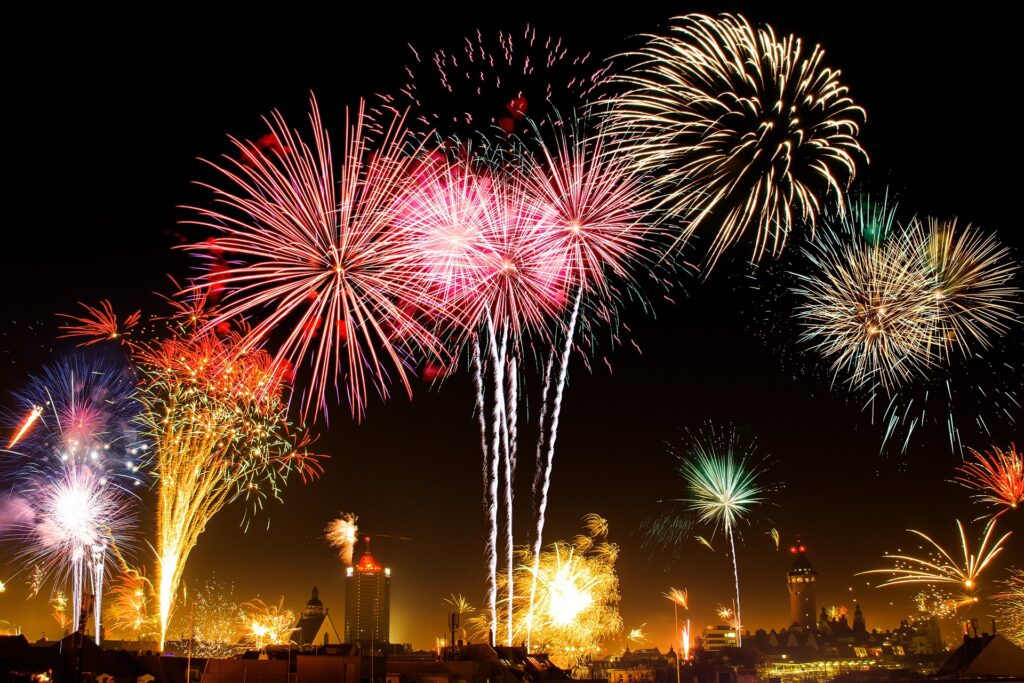History of New Year’s Day Celebrations


Overview
For over four thousand years, diverse cultures across the globe have marked the commencement of each new year. Presently, the majority of New Year’s celebrations initiate on December 31 (New Year’s Eve), the final day of the Gregorian calendar, extending into the early moments of January 1 (New Year’s Day). These celebrations are often characterized by attending lively gatherings, indulging in special New Year’s delicacies, crafting resolutions for the upcoming year, and witnessing vibrant displays of fireworks.
Early New Year’s Commemorations
The roots of celebrating the new year trace back approximately 4,000 years to ancient Babylon, where the onset of the new year was tied to the first new moon after the vernal equinox. This pivotal moment, characterized by equal parts daylight and darkness in late March, marked the commencement of festivities known as Akitu. Spanning 11 days, Akitu was a grand religious festival featuring distinct rituals each day.
Akitu wasn’t just a new year’s celebration; it also honored the legendary triumph of Marduk, the Babylonian sky god, over the malevolent sea goddess Tiamat. Beyond its spiritual significance, the festival held crucial political importance as it signified the coronation of a new king or the symbolic renewal of the reigning monarch’s divine authority.
In historical recalibrations, Julius Caesar found it necessary to readjust the Roman calendar to synchronize it with the sun. This led to the addition of 90 extra days in the year 46 B.C. upon the introduction of his revised Julian calendar.
Across ancient civilizations, various societies developed intricate calendars, typically establishing the new year’s start based on agricultural or astronomical events. For instance, in Egypt, the year commenced with the annual flooding of the Nile, coinciding with the appearance of Sirius, a significant star. Meanwhile, the Lunar New Year commenced with the second new moon following the winter solstice.
January 1 was designated as the commencement of the New Year’s festivities
The initial Roman calendar, devised by Romulus in the eighth century B.C., encompassed 10 months totaling 304 days, commencing each new year at the vernal equinox. Later, Numa Pompilius augmented it by incorporating Januarius and Februarius.
As time progressed, this calendar lost alignment with the sun’s cycles. In 46 B.C., Julius Caesar resolved this disparity by collaborating with leading astronomers and mathematicians, introducing the Julian calendar, akin to the Gregorian calendar utilized by most nations today.
Caesar’s reform designated January 1 as the year’s onset, in homage to Janus, the Roman god of beginnings, portrayed with dual countenances gazing into the past and future. Romans observed this occasion through Janus-centric rituals, exchanging gifts, adorning homes with laurel branches, and reveling in vibrant gatherings.
During medieval Europe, Christian leaders temporally displaced January 1 as the year’s commencement, favoring dates of heightened religious significance like December 25 (marking Jesus’ birth) and March 25 (the Feast of the Annunciation). It wasn’t until 1582, under Pope Gregory XIII’s decree, that January 1 was reinstated as New Year’s Day.
New Year’s Customs and Festivities across the Globe
In numerous nations, the commencement of New Year’s revelries takes place on December 31—known as New Year’s Eve—and extends into the early moments of January 1. During this time, celebrants often indulge in meals and snacks believed to bring good fortune for the upcoming year. For instance, in Spain and various Spanish-speaking regions, individuals hastily consume a dozen grapes right before midnight, symbolizing their aspirations for the months ahead.
Across the globe, customary New Year’s dishes frequently incorporate legumes, resembling coins and signifying anticipated financial prosperity. Italy embraces lentils, while the southern United States favors black-eyed peas. Pigs, symbolizing advancement and wealth in several cultures, feature prominently on New Year’s Eve tables in countries like Cuba, Austria, Hungary, and Portugal. Circular cakes and pastries, emblematic of the year completing a cycle, round off the feast in the Netherlands, Mexico, Greece, and other locales. In Sweden and Norway, a New Year’s Eve tradition involves serving rice pudding with a hidden almond; discovering the nut is believed to forecast 12 months of good luck.
In addition to these customs, there are globally recognized traditions such as witnessing fireworks displays and singing melodies to welcome the incoming year, with the perennial favorite “Auld Lang Syne” being popular in numerous English-speaking regions. The practice of crafting resolutions for the new year is believed to have originated from the ancient Babylonians, who made pledges to garner favor from the gods and commence the year on an auspicious note. Their vows often included commitments to settle debts and return borrowed agricultural tools.
In the United States, an iconic New Year’s tradition unfolds with the descent of a colossal ball in New York City’s Times Square at the stroke of midnight. This spectacle, observed by millions worldwide, has been an almost annual occurrence since 1907. Across the years, the ball itself has transformed from a 700-pound iron-and-wood sphere to a resplendent orb, 12 feet in diameter and weighing close to 12,000 pounds. Numerous towns and cities throughout America have developed their own interpretations of the Times Square ritual, orchestrating public drops of assorted items—ranging from pickles in Dillsburg, Pennsylvania, to possums in Tallapoosa, Georgia—at the stroke of midnight on New Year’s Eve.








